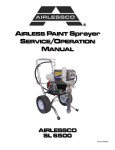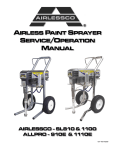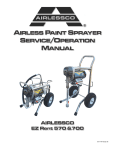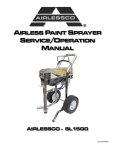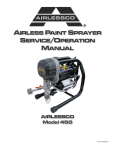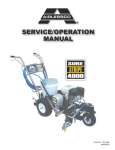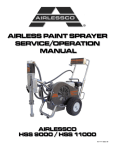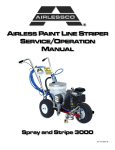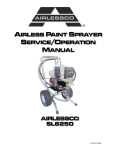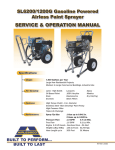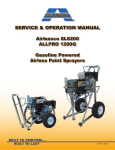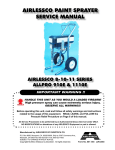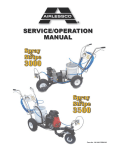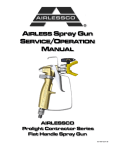Download AIRLESSCO SL 6250 Instruction manual
Transcript
® AIRLESS PAINT Sprayer SERVICE/OPERATION MANUAL AIRLESSCO SL 6250 001-809 APR 09 TABLE OF CONTENTS SECTION Introduction...................................................... 1 Safety Warnings .............................................. 2 Setting Up........................................................ 5 Flushing ........................................................... 5 How to Flush ................................................... 6 Starting Up ...................................................... 7 Pressure Relief Procedure .............................. 9 Airless Spray Gun Operation......................... 10 Airless Spray Gun ..........................................11 Airless Spray Troubleshooting....................... 12 Tip Selection.................................................. 13 Oil and Lubrication ........................................ 14 Regular Maintanence .................................... 14 Field Troubleshooting .................................... 15 Servicing the Fluid Pump .............................. 16 Servicing the Inlet Valve ................................ 17 Servicing the Outlet Valve ............................. 17 Packing Replacement Procedures ................ 18 Paint System Assembly ................................. 20 Prime Valve ................................................... 21 Manifold Filter ................................................ 21 Replacement of Electrical Control Board ...... 22 Pressure Calibration on the Control Board.... 22 Clutch Troubleshooting.................................. 23 Clutch Replacement ...................................... 23 Clutch Assembly ............................................ 25 Engine Assembly ........................................... 25 Power Unit Assembly .................................... 26 Frame Assembly............................................ 27 Suction Assembly .......................................... 27 Notes ............................................................. 28 Airlessco Accessories.................................... 30 Airlessco 5397 N. Commerce Ave, Moorpark, CA 93021 www.airlessco.com • (805) 523-0211 2 FIGURE 1 Filling the Packing Nut/Wet Cup................ 5 2. Spray Tip ................................................... 6 3. Prime Valve ............................................... 6 4. Pressure Control Knob .............................. 6 5. Choke, Fuel, Throttle ................................. 6 6. Static Discharge ........................................ 6 7. Spray Gun ............................................... 10 8. Gun Safety Latch..................................... 10 9. Major Gun Components .......................... 10 10. Spray Tip ................................................. 10 11. Airless Spray Gun .....................................11 12. Oil and Lubrication .................................. 14 13. Fluid Pump .............................................. 16 14. Fluid Pump Connection ........................... 16 15. Fluid Pump Connection ........................... 16 16. Fluid Pump Connection ........................... 16 17. Fluid Pump Connection ........................... 16 18. Fluid Pump Connection ........................... 16 19. Inlet Valve ................................................ 17 20. Outlet Valve ............................................. 17 21. V-Packing ................................................ 19 22. V-Packing Cutaway ................................. 19 23. Paint System ........................................... 20 24. Prime Valve ............................................. 21 25. Manifold Filter .......................................... 21 26. Control Board .......................................... 22 27. Belt Tensioning ........................................ 24 28. Clutch Assembly ...................................... 25 29. Engine Assembly ..................................... 25 30. Power Unit Assembly .............................. 26 31. Frame Assembly...................................... 27 32. Suction Assembly .................................... 27 INTRODUCTION This gas powered airless sprayer is built tough to take the day after day high volume demands of painting contractors and equipment rental companies. The SL "Slow Stroker" paint pump features a large, severe duty, slow-stroking stainless steel piston. Airlessco's patented stationary triple-life packing system allows external adjusment of upper & lower packings. This SL6250 airless pumps are "Built to Perform...Built to Last" using the latest technology in pump design for smooth operation and low maintenance. SL6250G Part No. (Bare) 301-693 Part No. (Complete) 301-694 Max Pressure 3000 PSI Output (FreeFlow) 1.70 GPM Output (At Pressure) 1.60 GPM Tip Size (1 Gun) 0.041 in. Tip Size (2 Gun) 0.029 in. Motor Honda GX160 Weight WARNING 136 lbs HANDLE THIS UNIT AS YOU WOULD A LOADED FIREARM! HIGH PRESSURE SPRAY CAN CAUSE EXTREMELY SERIOUS INJURY. OBSERVE ALL WARNINGS! MANUAL NOTATIONS WARNING - Alerts user to avoid or correct conditions that could cause bodily injury. CAUTION - Alerts user to avoid or correct conditions that could cause damage to or destruction of equipment. BEFORE OPERATING THIS UNIT, READ AND FOLLOW ALL SAFETY WARNINGS AND INSTRUCTIONS RELATED TO THE USAGE OF THIS EQUIPMENT ON PAGES 2, 3 & 4. READ, LEARN, AND FOLLOW THE PRESSURE RELIEF PROCEDURE ON PAGE 9 OF THIS MANUAL. IMPORTANT - Alerts users to steps or procedures that are essential to proper equipment repair and maintenance. NOTE - Identifies essential procedures or extra information. All Service Procedures to be performed by an Authorized Airlessco Service Center ONLY. NO MODIFICATIONS or alterations of any AIRLESSCO Equipment or part is allowed. 1 WARNINGS MEDICAL ALERT - Airless Spray Wounds If any fluid appears to penetrate your skin, get EMERGENCY MEDICAL CARE AT ONCE. DO NOT TREAT AS A SIMPLE CUT. Tell the doctor exactly what fluid was injected. Have him read the following "NOTE TO PHYSICIAN". WARNING HIGH PRESSURE SPRAY CAN CAUSE EXTREMELY SERIOUS INJURY. OBSERVE ALL WARNINGS. THIS SPRAYER IS FOR PROFESSIONAL USE ONLY. INJECTION HAZARD FLUIDS UNDER HIGH PRESSURE FROM SPRAY OR LEAKS CAN PENETRATE THE SKIN AND CAUSE EXTREMELY SERIOUS INJURY, INCLUDING THE NEED FOR AMPUTATION. NEVER point the spray gun towards anyone or at any part of the body. NEVER put hand or fingers over the spray tip. Do not use rag or other materials over your fingers. Paint will penetrate through material and into the hand. NEVER try to stop or deflect leaks with your hand or body. ALWAYS have gun tip guard in place when spraying. ALWAYS lock gun trigger when you stop spraying. ALWAYS remove tip from the gun to clean it. NEVER try to "blow back" paint, it’s not an air sprayer. ALWAYS follow the PRESSURE RELIEF PROCEDURE, as shown on page 9, before cleaning or removing the spray tip or servicing any system equipment. Be sure equipment safety devices are operating properly before each use. ALWAYS tighten all fluid connections before each use. MEDICAL TREATMENT If any fluid appears to penetrate your skin, get EMERGENCY CARE AT ONCE. DO NOT TREAT AS A SIMPLE CUT. • Go to an emergency room immediately. • Tell the doctor you suspect an injection injury. • Tell him what kind of material you were spraying with and have him read NOTE TO PHYSICIAN above. GENERAL PRECAUTION 2 NOTE TO PHYSICIAN: Injection in the skin is a traumatic injury. It is important to treat the injury surgically as soon as possible. DO NOT DELAY treatment to research toxicity. Toxicity is a concern with some exotic coatings injected directly into the blood stream. Consultation with a plastic surgeon or reconstructive hand surgeon may be advisable. NEVER alter equipment in any manner. NEVER smoke while in spraying area. NEVER spray highly flammable materials. NEVER use around children. NEVER allow another person to use sprayer unless he is thoroughly instructed on its' safe use and given this operators manual to read. ALWAYS wear a spray mask, gloves and protective eye wear while spraying. ALWAYS ensure fire extinquishing equipment is readily available and properly maintained. NEVER LEAVE SPRAYER UNATTENDED WITH PRESSURE IN THE SYSTEM. FOLLOW PRESSURE RELIEF PROCEDURES ON PAGE 9. ALWAYS INSPECT SPRAYING AREA Keep spraying area free from obstructions. Make sure area has good ventilation to safely remove vapors. NEVER keep flammable material in spraying area. NEVER spray in vicinity of open flame or other sources of ignition. Spraying area must be at least 20 ft. away from spray unit. SPRAY GUN SAFETY ALWAYS set safety lock on the gun in "LOCKED" position when not in use and before servicing or cleaning. DO NOT remove or modify any part of gun. ALWAYS remove spray tip when cleaning. Flush unit with LOWEST POSSIBLE PRESSURE. CHECK operation of all gun safety devices before each use. Be very careful when removing the spray tip or hose from gun. A plugged line contains fluid under pressure. If the tip or line is plugged, follow the PRESSURE RELIEF PROCEDURE as outlined on page 9.TIP GUARD TIP GUARD ALWAYS have the tip guard in place on the spray gun while spraying. The tip guard alerts you to the injection hazard and helps prevent accidentally placing your fingers or any part of your body close to the spray tip. SPRAY TIP SAFETY USE EXTREME CAUTION when cleaning or changing spray tips. If the spray tip clogs while spraying, engage the gun safety latch immediately. ALWAYS follow the PRESSURE RELIEF PROCEDURE before removing the spray tip to clean it. NEVER wipe off build up around the spray tip. ALWAYS remove tip & tip guard to clean AFTER pump is turned off and the pressure is relieved by following the PRESSURE RELIEF PROCEDURE. WARNINGS CONTINUED ON NEXT PAGE......... WARNINGS - CONTINUED ALWAYS INSPECT SPRAYING AREA Keep clear of moving parts when starting or operating the sprayer. Do not put your fingers into any openings to avoid amputation by moving parts or burns on hot parts.Precaution is the best insurance against an accident. When starting the engine, maintain a safe distance from moving parts of the equipment. Before adjusting or servicing any mechanical part of the sprayer, follow the PRESSURE RELIEF PROCEDURE on page 9, and remove the ignition cable from the spark plug to prevent accidental starting of sprayer. HOSES Tighten all fluid connections securely before each use. High pressure fluid can dislodge a loose coupling or allow high pressure spray to be emitted from the coupling and result in an injection injury or serious bodily injury. Use only hose that has a spring guard. The spring guard helps protect the hose from kinks or other damage which could result in hose rupture and cause an injection injury. NEVER use a damaged hose, which can result in hose failure or rupture and cause in injection injury or other serious bodily injury or bodily damage. Before each use, check entire hose for cuts, leaks, abrasion or bulging of cover, or damage or movement of couplings. If any of these conditions exist, replace the hose immediately. Never use tape or any device to try to mend the hose as it cannot contain the high pressure fluid. NEVER ATTEMPT TO RECOUPLE THE HOSE. High pressure hose is not recoupleable. Help prevent damage to the hose by handling and routing it carefully. Do not move the sprayer by pulling it with the hose. GROUNDING Ground the sprayer and other components in the system to reduce the risk of static sparking, fire or explosion which can result in serious bodily injury and property damage. ALWAYS GROUND ALL OF THESE COMPONENTS: 1. Sprayer: Connect a ground wire and clamp (supplied) to a true earth ground. 2. Fluid Hose: use only grounded hoses. 3. Spray gun or dispensing valve: grounding is obtained through connection to a properly grounded fluid hose and pump. 4. Object being sprayed: according to your local code. 5. All solvent pails used when flushing should only be metal pails which are conductive. Once each week, check electrical resistance of hose (when using multiple hose assemblies, check overall resistance of unpressurized hose must not exceed 29 megohms (max) for any coupled length or combination of hose lengths. If hose exceeds these limits, replace it immediately. Never exceed 500 Ft. (150 m.) overall combined hose length to assure electrical continuity. KEEP CLEAR OF MOVING PARTS Keep clear of moving parts when starting or operating the sprayer. Do not put your fingers into any openings to avoid amputation by moving parts or burns on hot parts. Precaution is the best insurance against an accident. When starting the engine, maintain a safe distance from moving parts of the equipment. Before adjusting or servicing any mechanical part of the sprayer, follow the PRESSURE RELIEF PROCEDURE on page 9, and remove the ignition cable from the spark plug to prevent accidental starting of sprayer. LABELING Keep all labels on the unit clean and readable. Replacement labels are available from manufacturer. TOXIC FLUID HAZARD Hazardous fluid or toxic fumes can cause serious injury or death if splashed in eyes or on skin, inhaled or swallowed. Know the hazards of the fluid you are using. Store & dispose of hazardous fluids according to manufacturer, local, state & national guidelines. ALWAYS wear protective eyewear, gloves, clothing and respirator as recommended by fluid manufacturer. WARNINGS CONTINUED ON NEXT PAGE......... 3 WARNINGS - CONTINUED AVOID COMPONENT RUPTURE This sprayer operates at 3000 psi (205 bar). ALWAYS be sure that all components and accessories have a maximum working pressure of at least 3000 psi to avoid rupture which can result in serious bodily injury including injection and property damage. NEVER leave a pressurized sprayer unattended to avoid accidental operation of it which could result in serious bodily injury. ALWAYS follow the PRESSURE RELIEF PROCEDURE whenever you stop spraying and before adjusting, removing or repairing any part of the sprayer. NEVER alter or modify any part of the equipment to avoid possible component rupture which could result in serious bodily injury and property damage. NEVER use weak or damaged or non-conductive paint hose. Do not allow kinking or crushing of hoses or allow it to vibrate against rough or sharp or hot surfaces. Before each use, check hoses for damage and wear and ensure all fluid connections are secure. REPLACE any damaged hose. NEVER use tape or any device to mend the hose. NEVER attempt to stop any leakage in the line or fittings with your hand or any part of the body. Turn off the unit and release pressure by following PRESSURE RELIEF PROCEDURE. ALWAYS use approved high pressure fittings and replacement parts. ALWAYS ensure fire extinquishing equipment is readily available and properly maintained. IMPORTANT: United States Government safety standards have been adopted under the Occupational Safety & Health Act. These standards, particularly the General Standards, Part 1910, & the Construction Standards, part 1926 should be consulted. WARNING Do not use halogenated solvents in this system. The prime valve, 2 gun manifold and most airless guns have aluminum parts and may explode. Cleaning agents, coatings, paints or adhesives may contain halogenated hydrocarbon solvents. DON"T TAKE CHANCES! Consult your material suppliers to be sure. Some of the most common of these solvents are: Carbontetrachloride, Chlorobenzene, Dichloroethane, Dichloroethyl Ether, Ethylbromide, Ethylchloride, Tethrachloethane. Alternate valves and guns are available if you need to use these solvents. 1. 2. 3. 4. 5. 4 PREVENT STATIC SPARKED FIRE/ EXPLOSIONS ALWAYS be sure all equipment and objects being sprayed are properly grounded. ALWAYS ground sprayer, paint bucket and object being sprayed. See "grounding" on page 3 for detailed grounding information. Vapors created when spraying can be ignited by sparks. To reduce the risk of fire, always locate the sprayer at least 20 feet (6 m.) away from the spray area. DO NOT plug in or unplug any electrical cords in the spray area, which can create sparks, when there is any chance of igniting vapors still in the air. Follow the coating & solvent manufacturers safety warnings and precautions. Use only conductive fluid hoses for airless applications. Be sure gun is grounded through hose connections. Check ground continuity in hose & equipment. Overall (end to end) resistance of unpressurized hose must not exceed 29 megohms for any coupled length or combination of hose length. Use only high pressure airless hoses with static wire approved for 3000 psi. FLUSHING Reduce the risk of injection injury, static sparking or splashing by following the specific cleaning procedure on page 6 and 9. ALWAYS follow the PRESSURE RELIEF PROCEDURE on page 9. ALWAYS remove the spray tip before flushing. Hold a metal part of the gun firmly to the side of a metal pail and use the lowest possible fluid pressure during flushing. NEVER use cleaning solvents with flash points below 140 degress F. Some of these are: acetone, benzene, ether, gasoline, naphtha. Consult your supplier to be sure. NEVER SMOKE IN THE SPRAYING/CLEANING AREA. NEVER leave water in fluid pump, to prevent freezing during storage. GAS ENGINE PRECAUTIONS Place unit 25 feet away from spraying in ventilated area. NEVER operate in buildings unless exhaust is piped outside. NEVER allow hose to lay against engine mufflers or hot parts. NEVER refill fuel tank while engine is hot or is running. WHEN SPRAYING & CLEANING WITH FLAMMABLE PAINTS OR THINNERS: When spraying with flammable liquids, the unit must be located a minimum of 25 feet away from the spraying area in a well ventilated area. Ventilation must be sufficient enough to prevent the accumulation of vapors. To eliminate electrostatic discharge, ground the spray unit, paint bucket and spraying object. Use only high pressure airless hoses approved for 3000 psi which is conductive. Remove spray tip before cleaning gun and hose. Make contact of gun with bucket and spray without the tip in a well ventilated area, into the grounded steel bucket. Never use high pressure in the cleaning process. USE MINIMUM PRESSURE. Do not smoke in spraying/cleaning area. SETTING UP 1. CONNECT THE HOSE AND GUN a. Remove the plastic cap plug from the outlet and screw a conductive or grounded 3000 psi spray hose onto fluid outlet. b. Connect an airless spray gun to the other end of the hose, but do not install the spray tip yet! NOTE: Do not use thread sealer on swivel unions as they are made to self seal. NOTE: The first 50’ of hose should always be 3/8". 2. FILL THE PACKING NUT/WET CUP Fill the Packing Nut/Wet Cup 1/3 full with Airlessco Throat Seal Oil (TSO). FIG 1 BELOW. FIG. 1 3. CHECK THE ENGINE OIL LEVEL a. Unscrew the oil fill plug. The dipstick is attached to the plug. b. Without threading the plug into place, check to be sure the oil is up to the top mark on the dipstick. c. If oil is needed, refer to engine manual. 4. FILL THE FUEL TANK WARNING: Fuel spilled on a hot surface can cause a fire or explosion and cause serious bodily injury and property damage. Always shut off the engine and let it cool before filling the tank, and carefully follow steps a - c below being sure not to spill any fuel. a. Close the fuel shutoff valve. b. Use only clean, fresh, well-known brands of unleaded regular grade gasoline. c. Remove the fuel cap and fill tank. Be sure the air vent in the fill cap is not plugged so fuel can flow to the carburetor, then replace the cap. FLUSHING 1. NEW SPRAYER Your unit was factory tested in an anti-freeze solution which was left in the pump. Before using oil-base paint, flush with mineral spirits only. Before using water-base paint flush with mineral spirits, followed by soapy water, then a clean water flush. 2. CHANGING COLORS Flush with a compatible solvent such as mineral spirits or water. 3. CHANGING FROM WATER-BASE TO OIL-BASE PAINT Flush with soapy water, then mineral spirits. 4. CHANGING FROM OIL-BASE TO WATER-BASE PAINT Flush with mineral spirits, followed by soapy water, then a clean water flush. 5. STORAGE Oil-base paint: Flush with mineral spirits. Water-base paint: Flush with water, then mineral spirits and leave the pump, hose and gun filled with mineral spirits. For longer storage, use mixture of mineral spirits and motor oil (half & half). Shut off the sprayer, follow PRESSURE RELIEF PROCEDURE on page 9 to relieve pressure and make sure prime valve is left open. ALWAYS store unit indoors. 6. START UP AFTER STORAGE Before using water-base paint, flush with soapy water and then a clean water flush. When using oil-base paint, flush out the mineral spirits with the material to be sprayed. 5 HOW TO FLUSH 1. Be sure the gun safety latch is engaged and there is no spray tip in the gun. Refer to Fig. 2. Refer to your separate instruction manual provided with your gun on its safety features and how to engage safety latch. 2. Pour enough clean, compatible solvent into a large, empty metal pail to fill the pump and hoses. 3. Place the suction tube into the pail or place the pail under the pump. 4. Turn pressure control knob to low. Refer to Fig. 4. 5. Open the prime valve to the open - "Priming Position". This will allow an easy start. Refer to Fig. 3. 6. Turn the engine ON/OFF switch to ON. 7. Move the choke toward the closed position as per Fig.5. 8. Move the throttle lever slightly to the left as per Fig.5. 9. Turn the fuel valve ON as per Fig. 5. Pull the start rope. Pull the engine over against compression stroke and then let the rope rewind slowly into the starter. Pull firmly and rapidly to start the engine. Do NOT drop the rope. Hold on to the handle while rewinding, or the rope may rewind improperly and jam the assembly. If the engine does not start, open the choke a little more. If the engine floods, open the choke all the way and continue cranking. 10. After the engine is warm, gradually close the choke, raise the RPM of engine slightly by moving throttle to the left. Close the prime valve. Refer to Fig. 3 11. Point the gun into the metal pail and hold a metal part of the gun firmly against the pail Refer to fig.6. 12. Disengage the gun safety latch and squeeze the gun trigger. At the same time, slowly turn the pressure control knob clockwise just enough to move liquid at low pressure. 13. Allow the pump to operate until clean solvent comes from the gun. 14. Release the trigger and engage the gun safety latch. 15. If you are going to start spraying, place the pump or suction tube into the supply container. Release the gun safety latch and trigger the gun into another empty, metal container, holding a metal part of the gun firmly against the metal pail (Fig. 6), forcing the solvent from the pump and hose. When paint starts coming from gun, turn pressure control knob to minimum pressure, place prime valve in prime (open) position and engage the gun safety latch. 16. If you are going to store the sprayer, remove the suction tube or pump from the solvent pail force the solvent from the pump and hose. Engage the gun safety latch and refer to the "Storage" Procedure on page 5. Step 5. 17. Whenever you shut off the sprayer follow the PRESSURE RELIEF PROCEDURE warning on page 9. FIG. 2 FIG. 3 PRIME VALVE CLOSED (Pressure) REMOVE SPRAY TIP. ENGAGE GUN SAFETY LATCH. FIG. 4 OPEN (Priming & Pressure Relief PRESSURE CONTROL KNOB HIGH PRESSURE FIG. 5 CHOKE LEVER FUEL VALVE THROTTLE LEVER FIG. 6 MAINTAIN FIRM METAL TO METAL CONTACT BETWEEN GUN AND CONTAINER WARNING: To reduce the risk of static sparking, which can cause fire or explosion, always hold a metal part of the gun firmly against the metal pail when flushing. This also reduces splashing. Refer to Fig 6. 6 STARTING UP 1. LEARN THE CONTROLS PRESSURE CONTROL KNOB - used to adjust pressure only. Turn clockwise to increase pressure and counterclockwise to decrease pressure. (See Fig. 4) PRIME & PRESSURE RELIEF VALVE - Turn to OPEN position (see Fig. 3) to prime the pump. Turn to the CLOSED position to spray. FOLLOW "PRESSURE RELIEF PROCEDURES" ON PAGE 9 WHENEVER YOU: - are instructed to relieve pressure - stop spraying - checking or servicing any of the system equipment. - or installing or cleaning the spray tip. HANDLE SPRAY SYSTEM AS YOU WOULD A LOADED FIREARM! CAUTION: Do not start engine without fluid pump having enough fluid so that it can be primed. Running fluid pump dry will decrease life of the pumps packings. 2. PREPARE THE MATERIAL a. Prepare the material according to the material manufacturer's recommendations. b. Place pump or suction tube into material container. 3. STARTING THE SPRAYER SEE FIGURE 3 & 6 ON PREVIOUS PAGE a. Prime Valve must be open - priming position. b. Pressure Control Knob must be in low pressure. c. Follow the procedure under "How to Flush", page 6, steps 6 through 12. WARNING If you spray into the paint bucket, always use the lowest spray pressure and maintain firm metal to metal contact between gun and container. See page 6, Fig 6. 5. ADJUSTING THE PRESSURE a. Turn the Pressure Control Knob Clockwise to increase pressure and counterclockwise to decrease pressure. b. Always use the lowest pressure necessary to completely atomize the material. NOTE: Operating the sprayer at higher pressure than needed, wastes material, causes early tip wear, and shortens sprayer life. c. If more coverage is needed, use a larger tip rather than increasing the pressure. d. Check the spray pattern. The tip size and angle determines the pattern width and flow rate. 6. REDUCING CLUTCH WEAR a. The first 50 feet of airless spray hose should be 3/8", the larger diameter works as a pulsation damper and saves unnecessary cycling of the clutch. A minimum of 100 feet of hose should be used. b. Adjust the Engine Speed and Pump Pressure. First set the throttle lever to the maximum RPM setting (fully left). Trigger the gun onto a test paper to check the spray pattern and atomization. Adjust the Pressure Control Knob until you get a good pattern. Reduce RPM of engine to support pressure without laboring engines. WARNING To stop the unit in an emergency or before performing any service or maintenance procedure follow the PRESSURE RELIEF PROCEDURE on page 9 to relieve the fluid pressure. 4. PRIME THE PUMP a. Allow pump to operate until paint comes from gun. b. Release the trigger and engage the gun safety latch. c. Turn Prime Valve OPEN to the prime position ensuring the pressure is released from the system. d. Turn Pressure Control Knob to minimum pressure. e. Install spray tip onto gun. f. Close the prime valve to the pressure position. g. Turn the pressure control knob to desired spray pressure. h. Disengage the gun safety lock and you are ready to start spraying. CONTINUED ON NEXT PAGE......... 7 STARTING UP CONTINUED 7. CLEANING A CLOGGED TIP a. Follow PRESSURE RELIEF PROCEDURE on page 9. b. Clean the front of the tip frequently (with toothbrush only) during the day to keep material from building up and clogging the tip. c. To clean and clear a tip if it clogs, refer to the separate instruction manual received with your gun and nozzle. IMPORTANT WARNING Always follow the PRESSURE RELIEF PROCEDURE on page 9 before perfoming any service or maintenance procedure. WARNING Never hold your body, fingers, or hand in a rag in front of the spray tip when cleaning or checking it for a cleared tip. Always point the gun toward the front or into a waste container when checking to see if the tip is cleared or when using a self-cleaning tip. THERE IS AN EASY WAY TO KEEP THE OUTSIDE OF THE TIP CLEAN FROM MATERIAL BUILD-UP: Every time you stop spraying, for even a minute, lock the gun and submerge the gun into a small bucket of thinner comparable with the material sprayed. Thinner will dissolve the build up of paint on the outside of tip, tip guard and gun much more effectively than if the paint dries out completely. WARNING Clogged standard flat tip - clean only after the tip is removed from the gun. Follow the PRESSURE RELIEF PROCEDURE Warning on Page 9. 8 8. WHEN SHUTTING OFF SPRAYER a. Whenever you stop spraying, even for a short break, follow the "PRESSURE RELIEF PROCEDURE ". b. Clean the tip & gun as recommended it the spray gun instruction manual. c. Flush the sprayer at the end of each work day, if the material you are spraying is water-based, or if it could harden in the sprayer overnight. See "Flushing". Use a compatible solvent to flush, then fill the pump and hoses with an oil based solvent such as mineral spirits. d. For long term shutdown or storage, refer to the "Flushing" section of this manual. WARNING Be sure to relieve pressure in the pump after filling with Airlessco Pump Conditioner. PRESSURE RELIEF PROCEDURE ! IMPORTANT! TO AVOID POSSIBLE SERIOUS BODY INJURY, ALWAYS FOLLOW THIS PROCEDURE WHENEVER THE SPRAYER IS SHUT OFF, WHEN CHECKING IT, WHEN INSTALLING, CHANGING OR CLEANING TIPS, WHENEVER YOU STOP SPRAYING, OR WHEN YOU ARE INSTRUCTED TO RELIEVE THE PRESSURE. 1. Engage the gun safety latch. Refer to the separate instruction manual provided with your gun on its safety features and how to engage safety latch. 4. Turn Prime/Pressure Relief Valve (PR Valve) to the open (priming) position to relieve residual fluid pressure. 2. Turn the unit off. 5. Re-engage gun safety latch and close Prime/Pressure Relief Valve. If you suspect that pressure hasn't been relieved due to damaged Prime/Pressure Relief Valve or other reason, engage the gun safety latch and take your unit to an authorized Airlessco Service Center. CL O S E EN HOLD METAL PART OF THE GUN IN CONTACT WITH GROUNDED METAL PAIL. USE MINIMUM PRESSURE ! If the SPRAY TIP OR HOSE IS CLOGGED, follow Step 1 through 5 above. Expect paint splashing into the bucket while relieving pressure during Step 4. OP 3. Disengage the gun safety latch and trigger the gun to relieve residual fluid pressure. DAILY MAINTENANCE 1. Keep the displacement pump packing nut/wet cup lubricated with Airlessco TSO (Throat Seal Oil) at all times. The TSO helps protect the rod and the packings. 2. Inspect the packing nut daily. Your pump has a patented Triple Life Packing System. Packing life will be extended a minimum of three times if the following "Packing Adjustment" procedure is followed: IF SEEPAGE OF PAINT INTO THE PACKING NUT AND/OR MOVEMENT OF THE PISTON UPWARD IS FOUND (WHILE NOT SPRAYING), THE PACKING NUT SHOULD BE TIGHTENED ENOUGH TO STOP LEAKAGE ONLY, BUT NOT ANY TIGHTER. OVERTIGHTENING WILL DAMAGE THE PACKINGS AND REDUCE THE PACKING LIFE. 9 AIRLESS SPRAY GUN OPERATION SPRAY Attach spray gun to airless unit and tighten fittings securely. Set the gun safety latch. (Also may be called gun safety lock, or trigger lock) FIG. 7 GUN SAFETY LATCH IN LOCKED POSITION GUN SAFETY LATCH * The gun safety latch should always be set when the gun is not being triggered. Read all warnings and safety precautions supplied with the spray gun and in product manual. RELEASED MAJOR COMPONENTS OF SPRAY GUN AND REVERSIBLE SPRAY TIP FIG. 8 GUN SAFETY LATCH OR LOCK FIG. 9 REV-TIP™ O-RING GASKET REV-GUARD™ REVERSIBLE SPRAY TIP TIP GUARD HANDLE (FILTER INSIDE) METAL SEAT TRIGGER GUARD SPRAY TIP ASSEMBLY CLEANING FILTER IN GUN HANDLE 1. Be sure pressure relief procedure is followed before assembling tip and housing to the gun. 2. Lock gun safety latch. 3. Insert REV-TIP™ cylinder into the REV-GUARD™ (guard housing assembly). 4. Guide metal seat into REV-GUARD™ (guard housing assembly) through retaining nut & turn until it seats against the cylinder. 5. Insert O-Ring gasket on metal seat so it fits in the grooves. 6. Finger tighten REV-GUARD™ retaining nut onto the gun. 7. Turn guard in the desired position. 8. Completely tighten the retaining nut. FIG. 10 RETAINING NUT 1. Lock gun safety latch. 2. Turn REV-TIP™ handle 180 degrees. 3. Disengage trigger lock & trigger gun into pail. 4. If the REV-TIP™ handle appears locked (resists turning), loosen the retaining nut. The handle will now turn easily. 5. Engage gun safety latch & return handle to the spray position. O-RING GASKET Part # 561-026 REVERSE TO UNPLUG Spray Position Shown CLOGGED FLAT TIP METAL SEAT Part # 561-029 CLEANING SPRAY GUN Immediately after the work is finished, flush the gun out with a solvent. Brush pins with solvent and oil them lightly so they will not collect dried paint. 10 TO REMOVE CLOGS FROM SPRAY TIP RETAINING NUT REV-GUARD™ GUARD HOUSING ASSEMBLY G Thread 7/8" 561-002 F Thread 11/16" 561-001 REV-TIP™ CYLINDER Part # 561-XXX To clean the filter, use a brush dipped in an appropriate solvent. Change or clean filters at least once a day. Some types of latex may require a filter change after four hours of operation. Should the spray tip become clogged, relieve pressure from hose by following the "PRESSURE RELIEF PROCEDURE." Secure gun with the safety latch, take off guard, take out the tip, soak in appropriate solvent & clean with a brush. (Do not use a needle or sharp pointed instrument to clean the tip. The tungsten carbide is brittle and can chip.) AIRLESS SPRAY GUN FIG. 11 6 7 8 11* 10 9 5 4 12 1* 3* 2* 13 14 15 16 17 PARTS LIST FIGURE 5 Item No. Part No. Description 1 120-530 Gun Seat Assembly 2 120-535 Gasket-Seat 3 120-520 Needle Assembly 4 120-529 Gun Seat Adapter 5 120-562 Trigger Guard 6 119-055 Screw 7 119-054 Nut 8 120-109 Gun Head 9 120-540 Actuator Pin (2) 10 120-536 Gun Plate 11* 120-038 Nut 12 120-056 Plastic Washer 13 120-538 Gun Trigger Lock 14 120-055 Wave Washer 15 120-049 Retaining Ring 16 120-082 Handle Seal 17 21 20 18 19 120-090CX Gun Filter-Coarse 120-090FX Gun Filter-Fine 18 120-088 Spring 19 120-106 Gun Handle Assy 20 120-542 2 Finger Gun Trigger 21 120-506 4 Finger Gun Trigger * 120-534 Gun Repair Kit 11 AIRLESS SPRAY TROUBLESHOOTING DEFECTS CAUSE CORRECTION Coarse spray Low pressure Increase the pressure Excessive fogging (overspray) High pressure Material too thin Reduce the pressure to satisfactory pattern distrabution Use less thinner Patten too wide Spray angle too large Use smaller spray angle tip Pattern too narrow Spray angle too small use larger spray angle tip ( if coverage is OK, try tip in same nozzle group) Too much material Nozzle too large Material too thin Pressure too high use smaller nozzle Nozzle too small use next larger nozzle material too thick Too little material reduce pressure Thin distribution in center Worn tip of pattern “horns” Wrong tip change to new tip use nozzle with narrow spray angle Thick skin on work Material too viscous Application too heavy thin cautiously reduce pressure and/or use tip in next smaller nozzle group Coating fails to close & smooth over Material too viscous thin cautiously Spray pattern irregular, deflected Orifice clogged Tip damaged clean carefully replace with new tip Craters or pock marks, bubbles on work Solvent balance use 1 to 3% “short solvents remainder “long” solvents (this is most likely to happen with material of low viscosity, lacquers, etc.) Clogged screens Extraneous material in paint Course pigments Poorly milled pigments (paint pigments glocculate) Clean screen Use coarse screen if orifice size allows. Use courser screen, larger orifice tips. Obtain ball milled paint. If thinner has been added, test to see if a cover screen. Incompatible drop placed on top of paint mixes or flattens out on the paint mixture & thinners on the surface. If not, try different thinner in fresh batch of paint. TEST THE PATTERN GOOD, FULL 12 SPOTTY PATTERN, INCREASE PRESSURE TIP SELECTION GUIDE Spray tip selection is based on paint viscosity, paint type, & job needs. For light viscosities (thin paints), use a smaller tip; heavier (thicker paints), use a larger tip size. Spray tip size is based on how many gallons of paint per minute can be sprayed through the tip. Do not use a tip larger than maximum pump flow rate or capacity the sprayer can accommodate. Pump flow rate is measured in gallons per minute (GPM). TIP IDENTIFICATION: 1ST 3-DIGITS identifies it as a REV-TIPTM for airless paint spraying (P.N. 560-xxx) or a REV-TIPTM for airless line striping (P.N. 562-xxxST). 4TH DIGIT is the fan width - the number is half the fan width, e.g., 5 means a 10” fan. 5TH AND 6TH digits are for the orifice size and is measured in thousandths of an inch, e.g., 17 = 0.017 inch - The higher the number, the larger the tip. SPRAY TIP - ORIFICE SIZE (INCHES) REV-TIPTM for Painting Fan Width (12” from surface) .029 .009 .011 .013 .015 .017 .019 .021 .023 .025 .027 .031 .035 .039 in. mm 4-6 102-152 209 211 213 215 217 219 221 223 225 227 6-8 152-203 309 311 313 315 317 319 321 323 325 327 8-10 203-254 409 411 413 415 417 419 421 423 425 427 431 10-12 254-305 12-14 305-356 14-16 16-18 229 335 513 515 517 519 521 523 525 527 531 535 613 615 617 619 621 623 625 627 631 635 356-406 715 717 406-457 815 20-24 508-610 Gun Filter C=course-60 mesh Wood Interior Lacquer, Varnish, 511 721 819 821 .041 639 641 739 741, 754 831 NEW WIDE TIPS: W21 W23 W25 W28 W29 W31 C C • • • Elastomer • • • • • Ceiling Hi Build, Mil White • • Structural Steel Heaviy Coatings • • Water Flow Rate (gpm) (lpm) .12 .49 .18 .69 .24 .91 .31 .38 .47 1.17 1.47 1.79 .57 .67 .77 1.03 1.31 1.63 2.15 2.54 2.96 3.90 4.98 6.17 1.80 6.81 (gpm) (lpm) .10 .38 .15 .57 .21 .79 .27 .33 .40 .49 .58 .66 .88 1.12 1.39 1.02 1.25 1.51 1.85 2.20 2.50 3.33 4.24 5.26 1.54 5.83 (gpm) (lpm) .25 1.0 .25 1.0 .33 1.25 .40 1.5 2.2 8.2 F=Fine-100 mesh Stain, Sealer, Enamel Wood Exterior Masonry F F • • • Exterior Stain, Vinyl, Acrylic, Latex Vinyl, Oil Base, Alkyd, Latex, Acrylic, Block Filler, @ 2000psi, 138 bar Paint Flow Rate latex paint @ 2000psi, F, C C C REMOVE FILTER • • • • • • • • • • • • • • • • • • • • • • • • • 138 bar/1.36 spec. gr. Pump Minimum Output* .50 1.9 .60 2.3 .75 2.8 .88 3.3 1.0 3.8 1.25 4.7 1.5 5.7 2.0 8.2 *Pump will support tip worn to next larger size. Thickness of the paint coat per stroke is determined by spray tip "fan width", rate of the spray gun movement, and distance to surface. Two tips having the same tip size, but different pattern widths will deliver the same amount of paint over a different area (wider or narrower strip). A spray tip with a narrow pattern width makes it easy to spray in tight places. During use, especially with latex paint, high pressure will cause the orifice to grow larger. This destroys the pattern. Replace tips before they become excessively worn. Worn tips waste paint, cause overspray, make cutting-in difficult, and decreases sprayer performance. 13 REGULAR MAINTENANCE 1. Always stop the pump at the bottom of its stroke when you take a break or at the end of the day. This helps keep material from drying on the rod, damaging the packings. 2. Keep the displacement pump packing nut/wet cup 1/3 full of Airlessco Throat Seal Oil at all times. The TSO helps protect the packings and rod. 3. Lubricate Connecting Rod Pin every 3 months. 4. Inspect the packing nut daily. Your paint pump has Airlessco's patented "Triple Life Packing System". Packing life will be extended a minimum of 3 times if the proper packing tightening procedure is followed! PACKING TIGHTENING PROCEDURE: Inspect the packing nut daily!If seepage of paint into the packing nut and/ or movement of the piston upward is found (while not spraying), the packing nut should be tightened enough to stop leakage only, but not any tighter. OVERTIGHTENING WILL DAMAGE THE PACKINGS and reduce the packing life to the life of other piston pumps. OIL AND LUBRICATION INSTRUCTIONS BLEED (WEEP HOLE) FIG. 12 SEALED BEARING 1 OZ. SAE 30 W OIL SEMI-ANNUALLY OIL IMPREGNATED SLEEVEDIP IN HOT 10 W OIL WHEN REMOVED 14 FILL PLUG- UNIT HAS GREASE IN GEARBOX FROM FACTORY AND WILL NOT REQUIRE CHANGING. (GREASE - PN: 301-178) FIELD TROUBLESHOOTING PROBLEM CAUSE SOLUTION There is spitting from the gun. The fluid supply is low or empty. Air entrapped in the fluid pump or hose. Refill the supply container. Check for loose connections on the siphon assembly, tighten, then reprime pump. Paint leaks into the wet cup The packing nut/wet cup is loose. The upper packings are worn or damaged. Worn Piston Rod. Tighten just enough to stop leakage. Replace the packings. See pages 18-19. Replace Piston Rod The engine operates, but The pressure setting is too low. the paint pump doesn't The clutch is not engaged. cycle. The displacement pump is seized. Increase the pressure. See page 6. See Troubleshooting pg. 23. Service the pump. See page 18-19. The engine and displacement pump operates, but paint pressure is too low or none The pressure setting is too low. The tip or gun filter is clogged. The tip is worn. The fluid displacement pump filter is clogged. There is a large pressure drop in the fluid hose. Increase the pressure, see page 6. Remove the tip and/or filter and clean them. Replace Tip. Clean the filter. The displacement pump operates, but the output is too low on the downstroke or both strokes. The inlet valve ball is not seating properly. Service the inlet valve see page 17. The displacement pump operates, but the output is too low on the upstroke. The outlet valve ball is not seating properly. Service the outlet valve per page 17. The lower packings are worn or damaged. Replace the packings. See page 18-19. Use a larger diameter hose. Clutch does not engage. Clutch slippage. See Troubleshooting page 23. Call Authorized Service Center. Engine stops Refer to Engine Manual. 15 SERVICING THE FLUID PUMP NOTE: CHECK EVERYTHING IN THE TROUBLESHOOTING CHART BEFORE DISASSEMBLING THE SPRAYER. FLUID PUMP REINSTALL FLUID PUMP DISCONNECT 1. Loosen the packing nut & extend piston rod to fully up position. See figure 14. 2. Insert one of the retaining rings through the packing nut and rest the sleeve on top of it. See figure 15 & 16. 3. Connect the connecting rod with the fluid pump by installing the coupling halves. Slide sleeve over the coupling halves and secure with retaining ring. See figure 17. 4. Remove the retaining ring from the packing nut and insert into coupling halves. See figure 18. 5. Secure the fluid pump housing to the tie rods and screw locknuts with washers on loosely. 6. Tighten the tie rod locknuts evenly to 30 ft. lb. 1. Flush out the material you are spraying, if possible. 2. Follow the Pressure Relief Procedure on page 9. Stop the pump in the middle of down stroke. 3. Remove the suction tube and fluid hose (if so equipped) from the fluid pump. 4. Remove the connecting rod shield from the pump. 5. Remove 2 retaining rings and slip the sleeve of the coupling down and remove both coupling halves. This will disconnect fluid pump from the connecting rod. 6. Using a 7/8” box wrench, disconnect the high pressure fluid line from the pump. 7. Using a 9/16” wrench, unscrew the two tie rod locknuts. 8. Pull the pump off the tie rods. FIG. 14 FIG. 15 NOTE: AFTER ALL THE ROD LOCKNUTS ARE TIGHT, THE ALIGNMENT OF BOTH RODS SHOULD ALLOW EASY ASSEMBLY AND DISASSEMBLY OF THE COUPLING. IF ANY BINDING, LOOSEN AND RETIGHTEN ALL THE ROD LOCKNUTS TO IMPROVE THE ALIGNMENT. MISALIGNMENT CAUSES PREMATURE WEAR OF SEAL AND PACKINGS. 7. Tighten packing nut clockwise until resistance against the packings can be felt. Turn it one full turn more. 8. Start the pump and operate it slowly (at low engine speed) to check the piston rod for binding. Adjust tie rod lock nuts if necessary to eliminate binding. 9. Prime the unit and run at maximum pressure for several minutes, then release the pressure & repeat step 7. 10. Fill the wet cup (packing nut) with five drops of TSO (Throat Seal Oil). FIG. 13 1 FIG. 16 2 FIG. 17 PARTS LIST FIGURE 13 3 4 5 6 4 7 8 Item No. 13 12 11 10 9 16 1 Part No. Description 301-204-99 Gearbox 1” 2 301-320 Cover 3 301-046 Rod End 4 189-048 Retaining Ring 5 189-046 Coupling Set 6 198-047 Retaining Sleeve 7 301-467 Front Shield 8 187-410 SL Paint Pump Assy 9 187-002 Suction Nut 10 140-051 Nut (2) 11 140-035 Lock Washer (2) 12 301-059 Spacer (2) 13 100-328 Stud (2) FIG. 18 SERVICING INLET & OUTLET VALVES DISASSEMBLY OF THE OUTLET VALVE FIG. 19 1 1. Using the rod collar tool (189-211) , screw the suction nut, containing intake seat support, off of the fluid body. See Fig. 19. 2. Remove the inlet seat, O-ring, inlet ball and inlet retainer with O-ring. See Fig. 19. 3. Clean all parts and inspect them for wear or damage, replacing parts as needed. Old O-rings should be replaced with new ones. NOTE: INLET SEAT (187-065) IS REVERSIBLE. 4. Clean inside of fluid body. 5. Reassemble the valve and screw it onto the fluid body if no further service is needed. 2 3 4 5 SERVICING THE OUTLET VALVE 1. Complete all steps of the Fluid Pump Disconnect procedure on page 16. 2. Screw the suction nut off the pump and remove inlet valve assembly. 3. Using the rod collar tool, loosen the packing nut and push the piston down and out of the fluid body. 4. Place piston holder (187-248) in a vise. Slide piston into holder and lock in place with a 1/4" pin (187-250). 5. Clean all parts and inspect them carefully for wear or damage. Inspect the outside of the piston rod for scoring or wear. Replace these parts if needed. A worn piston rod will cause premature wear of packings. 6. Using 3/8" allen wrench to unscrew retainer from piston. 7. Remove outlet seat, O-ring, outlet ball and outlet retainer. 8. Inspect outlet ball and seat for wear. Replace as required. NOTE: OUTLET SEAT (187-061) IS REVERSIBLE. 9. Install parts back into piston rod as per Fig. 20. Place two drops of loctite No. 242 (blue) on threads of the retainer before assembling and torque to 20 ft-lbs. 6 7 FIG. 20 8 9 10 11 12 PARTS LIST FIGURE 19 & 20 Item No. Part No. 1 106-014 Black O-Ring 2 187-016 Inlet Retainer 3 187-020 Inlet Ball 4 187-065 Inlet Seat 5 106-017 White O-Ring 6 187-001 Suction Fitting 7 187-002 Suction Nut 8 187-051 Retainer 9 187-061 Outlet Seat 10 106-021 White O-Ring 11 115-022 Outlet Ball 12 187-062 Outlet Retainer 13 Description 13 187-248 187-250 187-330-99 Piston 17 PACKING REPLACEMENT PROCEDURES DISASSEMBLY OF THE FLUID PUMP 1. Unscrew & remove the packing nut. 2. Push the piston rod down through the packings & out of the pump. 3. Now push the packing removal tool up through the pump & remove from the top bringing the packings, spacer & springs along with it, leaving the fluid body empty. *NOTE: MAKE SURE ALL PACKINGS & GLANDS HAVE BEEN REMOVED FROM THE FLUID PUMP. 4. Clean inside of fluid body. 5. Disassemble all parts & clean for reassembly. Discard any old packings. Save the metal upper glands. Replace metal lower glands with new metal glands from the packing kit. * NOTE: IF THE OLD PACKING HAD A METAL GLAND FOR (187-058), DISCARD & REPLACE WITH A NEW PLASTIC ONE FROM PACKING KIT. 6. Lubricate leather packing in lightweight oil for 10 minutes prior to reassembly. REASSEMBLY 1. Take the lower metal male gland and place it down on the flat side. 2. Take three of the lower polyethylene V-packings and two of the leather V-packings and place onto your male gland in the following order with the inverted side down: polyethylene, leather, polyethylene, leather, polyethylene. 3. Take the female adaptor, which is inverted on both sides, and place it on top of your assembled lower packings. 4. Follow step 2 above but with packings inverted side up. 5. Take the second lower male gland and place it on top of your assembled packings with the rounded side down. 6. Take your assembled glands & packings (13 pieces all ogether) and slide on to the lower half of the piston. 7. Take the spacer and slide over the top of the piston (it doesn’t matter which direction it sits), falling onto the lower packings. 8. Take the three Belleville Springs and slide over the top of the piston in the following order: * First spring, curve facing down * Second spring, curve facing up * Third spring, curve facing down 9. Take the upper male gland and place it with the rounded side up. 10. Take the three upper polyethylene V-packings and two leather packings and assemble with the inverted side down, on to the male gland in the following order: polyethylene, leather, polyethylene, leather, polyethylene. 18 11. Take the upper female gland & place on top of your assembled upper packings with the inverted side down. 12. Take your assembled upper glands and packings (7 pieces) and slide on over the top of the piston, making sure the inverted sides are facing down. 13. Take the V-packing holder and replace the white O-ring and the black O-ring with new ones from the packing kit. 14. Slide the V-packing holder over the top of the upper packings so they fit inside. 15. Lubricate the inside of the fluid pump body and the outside of the packings with a light weight oil. 16. Slide the completed assembly into the fluid pump body. *NOTE: TO KEEP PACKINGS SECURED IN THE CORRECT POSITION, HOLDTHE PUMP BODY UPSIDE DOWN AND PUSH THE COMPLETED ASSEMBLY UPWARDS INTO THE PUMP BODY. ONCE PLACED INSIDE, TILT THE PUMP BODY BACK UP TO KEEP ALL PIECES. 17. Thread the packing nut into the top of the fluid body and tighten hand tight. 18. Take the suction retainer and replace the black O-ring with a new one from the packing kit. Replace the suction ball with the new one from the kit into the suction retainer. Place the suction seat into the flat side of the ball guide, over the suction ball. Now place the white O-ring into the groove around the suction seat. 19. Take the completed suction valve assembly and place it into the bottom of the fluid body, with the rounded side fitting inside. 20. Take the suction seat support and place the flat side down on to the suction valve assembly (threads will be facing upwards). 21. Thread the suction nut, over the suction seat support. 22. Tighten the packing nut (utilizing the packing nut adjustment tool) clockwise one full turn. PACKING REPLACEMENT PROCEDURES FIG. 21 FIG. 22 23 22 1 24 25 2 21 22 20 19 20 21 19 3 18 18 4 15 16 4 1 5 6 7 8 9 14 17 16 15 10 15 16 14 11 12 14 17 13 16 15 PARTS LIST FIGURE 21 & 22 Item No. 1 Part No. Description 187-330-99 Piston Rod PARTS LIST FIGURE 21 & 22 CONT Item No. Part No. Description 14 187-059 Packing Leather 2 187-046 Packing Nut 15 187-037 Male Gland 3 187-313 Fluid Body 16 187-029 Packing Polyethylene 4 187-315 Spacer 17 187-058 Female Adaptor 5 106-021 O-Ring 18 187-031 Belleville Springs 6 187-062 Ball Guide 19 187-025 Male Gland 7 115-022 Outlet Ball 20 187-060 Packing Leather 8 187-061 Outlet Seat 21 187-030 Packing Polyethylene 9 187-051 Outlet Seat Support 22 187-026 Female Gland 10 187-016 Suction Retainer 23 187-047 Packing Holder 11 187-020 Suction Ball 24 106-012 White O-Ring 12 187-065 Suction Seat 25 106-013 Black O-Ring 13 106-014 O-Ring 19 PAINT SYSTEM ASSEMBLY FIG. 23 9 10 11 12 SEE FIGURE 22 13 8 14 7 6 9 5 5 16 15 4 3 1 17 2 PARTS LIST FIGURE 23 Item No. Part No. 1 120-504 2 Item No. Part No. Pro Light Gun (Optional) 10 301-253 Manifold 100-011 Hose (Optional) 11 100-317 Nut (2) 3 100-109 Nipple 12 100-345 Bolt (2) 4 100-023 Hose 13 169-013 Elbow 5 169-010 Nipple 14 100-123 Hose 6 100-028 Plug 15 100-036 Tee 16 119-083 Prime Valve 17 119-086 Bypass Hose Assy 7 20 Description PARTS LIST FIGURE 23 CONT 111-200-99 Manifold Filter Assy 8 301-309 Hose 9 167-016 Elbow Description PRIME VALVE (119-083) FIG. 24 1 2 3 4 PARTS LIST FIGURE 24 5 6 7 8 9 10 11 12 13 14 Item No. Part No. Description 1 115-303 Handle with Label 2 117-046 Screw 3 115-063 Washer 4 115-072 Spacer 5 115-064 Belleville Spring (3) 6 115-065 Retaining Ring 7 115-067 Washer 8 115-071 Valve Stem 9 115-068 O-Ring Black 10 115-069 Ball 11 115-029 Valve Seat 12 115-012 Washer 13 115-073 Valve Body 14 115-074 Inlet Fitting MANIFOLD FILTER (111-200-99) FIG. 25 1 2 3 4 5 6 7 9 8 10 PARTS LIST FIGURE 25 Item No. Part No. Description 1 111-202 Base 2 301-356 Spring 3 106-007 O-Ring 4 111-204 Filter 60 Mesh 5 111-203 Support 6 111-201 Base 7 100-159 Swivel 8 100-129 Plug 3/8” (2) 9 100-109 Nipple 3/8”M x 1/4”M 10 100-028 Plug 1/4” 21 REPLACEMENT OF ELECTRICAL CONTROL BOARD 1. Remove electrical cover. 2. Disconnect sensor lead from Electrical Board. 3. Disconnect two clutch leads on Electrical Board from leads on clutch. 4. Using a 1/16" allen, loosen set screw in Pressure Control Knob and remove knob. 5. Using a 1/2" nutdriver or 1/2" deep socket, remove nut from pressure control shaft. This will allow removal of electrical control board from frame. 6. Replace Electrical Board Assembly in reverse order. Adjust pressure as per procedure below, "Pressure Calibration on the Electrical Control Board". PRESSURE CALIBRATION OF THE ELECTRICAL CONTROL BOARD 1. Turn "Pressure Calibration" Trimpot adjustment on electrical control board in the counter clockwise direction at least 15 revolutions. 2. Connect 5000 psi glycerine pressure guage on outlet of pump between fluid pump & airless hose to monitor Fluid Pump Pressure. 3. Start engine and run at maximum RPM. Turn Prime Valve to the open (Prime) position. Turn Pressure Control Knob to maximum position (fully clockwise). FIG. 26 BLACK SENSOR 4 PRESSURE CALIBRATION TRIMPOT 3 BLACK GREEN BLUE BLACK TO ENGINE PARTS LIST FIGURE 26 22 5. Trigger gun. The pressure should drop approximately 350-400 psi, the clutch will engage and build pressure to 3000 psi and disengage. Trigger gun several times to ensure proper pressure setting. 6. Turn Pressure Control Knob to minimum position. The clutch should disengage and pump stop moving. 7. Secure leads with tie strap. 8. Replace cover on unit. Ensure the leads are not pinched or damaged in the process of replacing covers. BLUE 2 Part No. 1 106-019 2 301-523A 3 117-045 4 THE PUMP WILL BEGIN TO PRESSURIZE AND THE CLUTCH WILL DISENGAGE AT A LOW PRESSURE. CONTINUE TURNING THE TRIMPOT CLOCKWISE TO INCREASE PRESSURE TO 3000 PSI. BLACK 1 Item No. 4. Using an insulated screwdriver, adjust "Pressure Calibration" Trimpot by turning clockwise until the clutch engages. When the clutch engages the pump will commence Priming. When pump is primed, turn the Prime Valve to the Closed (Pressure) Position. Description O-Ring Knob Grommet 301-282-99 Control Board TO CLUTCH (301-284) ELECTRICAL TROUBLESHOOTING - Clutch Does Not Engage STEP 1: Ensure that the pressure control knob (POT) is in the maximum (CW) position. STEP 2: Remove the upper and lower clutch and electrical covers. STEP 3: Check all electrical connections between the engine magneto, sensor, control board and clutch for loose connections or damaged leads. See Fig.26. STEP 4: Disconnect the two leads from the control board (blue) and the clutch assembly (black). Using a multimeter, with the engine at maximum RPM, pressure control knob in the maximum position and the prime valve open (priming) position, test the DC voltage across the boards leads (blue). This voltage must be 13-14 VDC. If the readings are correct, the board, sensor and magneto are okay and the problem is the clutch assembly. If this is the case, proceed to Step 5. If the voltage is outside this range go to Step 7. STEP 5: Measure resistance between the clutch leads (black). This value must be 10-16 ohms. If this reading is out of specifications the clutch is defective and must be replaced, otherwise continue troubleshooting. STEP 6: If the clutch resistance readings of Step 5 are correct, check spacing between the clutch field and plate. The gap should be .012” to .024”. If the gap is greater than .024 the gap is too wide. If this gap is too wide, remove the spacer (Fig. 28, Item 7) from the clutch assembly. Should the clutch still not engage, replace the clutch assembly. See below. STEP 7: When the DC voltage from the board is not 13-14 VDC, disconnect the control board lead (black) from the engine magneto lead (pink), located on the side of the engine. With the engine at maximum RPM, pressure control knob in maximum (CW) position and prime valve open (priming), read the AC voltage from the magneto lead to the sprayer frame. This reading should be 19-24 VAC. If outside this range, contact your local Honda repair facility for magneto replacement. If the magneto is producing the proper AC voltage, continue to Step 8. STEP 8: Test the sensor by reading the resistance between the red and black wires. The resistance runs between 1.5-3 kohms. A defective sensor usually shows no resistance (open). If the reading is outside standards, replace the sensor. An alternative method to test the sensor, is to plug a new sensor into the board and see if the clutch will engage. Caution! When using this method, ensure prime/pressure valve is in the prime position. This is important because the sensor plugged into the board is not measuring pressure in the fluid section. STEP 9: When Steps 7 & 8 have been completed and the magneto and sensor check good, the electrical control board is the only item left, replace the board. See page 22. CLUTCH REPLACEMENT REMOVING THE CLUTCH REFER TO FIGURES 26-30 1. Remove the gear box cover (Fig 30, item 1) by disconnecting fluid hose to the manifold filter and by unscrewing the four allen head bolts (Fig 30, item 36). 2. Disconnect the fluid pump as described on page 16. 3. Pull off the spacer tubes (Fig 30, item 30) and drop the sleeve bearing down and off. Slide the connecting rod off the gear box. 4. Remove the top cover (Fig 30, item 2) by unscrewing the 6 mounting screws. be careful not to lose the 6 matching grommets. 5. Remove the bottom cover (Fig 30, item 14) by unscrewing the 2 bolts and nuts. 6. Remove the splash cover (Fig 30, item 12) from the clutch brackets and spacer tubes. 7. Disconnect the two clutch leads from the electrical control board leads and the clutch spring (Fig 28, item 9) from the spacer tube. 8. Loosen (do not remove completely) the block tensioner's set screws (Fig 27, item 6) to detension the belt. 9. Loosen (do not remove yet) the four plate bolts. 10.Pull the cog belt loose from the engine shaft cog pulley and let hang loose on the clutch cog pulley. 11.Remove the two vertical bracket screws (Fig 30, item 20). 12.Remove the four horizontal screws throught the gearbox plate (Fig 27, item 5) and lift the gear box off the machine. 13. Place gearbox in vice by gripping the flat part of the drive crank allowing the clutch assembly to face up. Use caution and not allow gearbox to swing and damage casting against vice. 14. Hold coupling screw, with 13/16" wrench, then with 5/16" allen wrench, screw differential screw out of coupling screw and gearbox shaft. 15.Remove the coupling screw from the clutch bore. NOTE: AFTER EXTENDED USE THE COUPLING SCREW CAN HANG UP INSIDE OF THE CLUTCH BORE. TAPPING ON THE SIDE OF THE COUPLING SCREW AND/OR THE USE OF A LIGHTWEIGHT OIL OR BREAK FREE PRODUCT CAN EASE THE REMOVAL PROCESS. IN EXTREME CASES, SCREW THE DIFFERENTIAL SCREW LARGE THREAD SIZE IN, THEN PLACE A WASHER AND NUT ON THE SMALL THREAD SIDE. THIS ALLOWS THE PULLING OR PRYING ON THE COUPLING SCREW IN ORDER TO REMOVE IT. 11.The clutch and other components can now be slide off the gear box shaft. 23 CLUTCH REPLACEMENT INSPECTING THE CLUTCH 1. Inspect clutch and belt, replace as neccessary. INSTALLING THE CLUTCH REFER TO FIGURES 27-30 1. With gearbox held in a vice vertically as previously described, place first spacer, and bearing, onto gearbox shaft. See Fig. 28 2. Insert snap rings (2), into recesses of cog pulley portion of clutch. Place cog pulley portion of clutch with cog belt attached onto shaft. 3. Place second spacer, into cog pulley portion of clutch. This spacer will rest on the first bearing, installed. 4. Insert second bearing, on top of upper snap ring, 5. Lay removable spacer on top of last bearing. If the clutch air gap is larger than .024", do not use removable spacer. Put spacer over removable spacer, if used, and top bearing. 6. Place coil portion of clutch down onto cog pulley portion of clutch and center on gearbox shaft. 7. Screw differential screw, into coupling screw and nut until 1/16" is showing. See Fig. 28 8. Push coupling nut assembly, into clutch assembly until it comes to a positive stop. (Differential screw comes into contact with the threaded gearbox shaft.) 9. With 13/16" wrench on coupling screw and 5/16" allen wrench in differential screw, simultaneously with both wrenches screw coupling nut assembly into gearbox shaft by turning clockwise until a positive stop is reached. 10. Hold coupling nut ass'y and tighten diffential screw to 30 ft.-lbs. This will expand the coupling assembly, thereby holding the clutch assembly to gearbox shaft. Turn clutch observing clutch gap. The pulley should turn freely with a gap of .012 to .024" between the two clutch faces. If the gap is greater than .024, remove the removable spacer. Reassemble and check gap for proper clearance. 11.Place cog belt over cog pulley portion of clutch. Set gearbox and clutch assembly on the support brackets (Fig 30, items 25 & 26), screw in the two vertical bracket screws (Fig 30, item 20) and start the four horizontal screws throught the gearbox plate (Fig 27, item 5) and into the back of the gearbox. 12. Slide cog belt over engine pulley 24 BELT TENSIONING 13. Slightly loosen the two horizontal screws (Fig 30, items 19-22) that connect the top and bottom supports (Fig 30, items 24 & 25). 14. Evenly tighten set screws (Fig 27, item 6) until flush with tip of block tensioner (Fig 27, item 7) . Check tension on cog belt by pressing hard with thumb. Proper tensioning should allow for approximately 1/8". If belt is too loose, tighten set screws further. 15. Once belt tension is correct tighten down the four horizontal screws that go through the gearbox plate (Fig 30, item 8) and into the back of the gearbox. Also tighten the two horizontal screws (Fig 30, items 19-20) that connect the top and bottom supports (Fig 31, items 24 & 25). Reconfirm that the belt deflection is still 1/8". 15. Reassembly connections, covers and fluid pump in reverse order as described in steps 1-7 of the "Removing Clutch" instructions. FIG. 27 6 7 5 8 9 10 4 3 2 1 PARTS LIST FIGURE 27 Item No. Part No. Description 1 301-231 Cog Belt 2 301-284 Clutch Replacement 3 305-088 Screw 4 100-175 Shoulder Screw 5 100-173 Screw Flanged (4) 6 100-174 Set Screw (2) 7 301-534 Block Tensioner 8 301-208 Gearbox 9 305-045 Plate 10 305-046 Spacer Tube CLUTCH ASSEMBLY (301-284) FIG. 28 10 9 8 7 6 5 1 2 PARTS LIST FIGURE 28 4 3 1 Item No. Part No. 1 112-041 Differential Screw 2 112-054 Coupling Nut Assy 3 4 1/16” 2 Description 301-284-99 Replacement Clutch 301-037 Bearing (2) 5 301-274 Spacer (2) 6 100-333 Retaining Ring (2) 7 301-413 Removable Spacer 8 301-412 Spacer 9 136-068 Spring 10 301-316 Rubber Edge ENGINE ASSEMBLY FIG. 29 PARTS LIST FIGURE 29 1 2 3 4 5 6 7 8 9 Item No. Part No. Description 1 301-160 Honda GX160 Engine 2 305-012 Adaptor 3 136-091 Screw (4) 4 112-029 Key 5 100-357 Set Screw 6 100-383 Screw (4) 7 301-222A Sheave Assy 8 301-229 Thrust Plate 9 301-230 Screw 25 POWER UNIT ASSEMBLY (301-593) FIG. 30 1 2 FIGURE 26 8 3 4 9 FIGURE 23 10 11 7 6 40 5 12 13 35 32, 33, 34 39 38 37 3 14 31 36 17, 18 28, 29, 30 20, 21 FIGURE 22 FIGURE 32 27 26 25 PARTS LIST FIGURE 30 26 Item No. Part No. 1 301-320 2 3 Description 16 15 19 20, 21, 22, 23 21, 22, 23, 24 FIGURE 28 FIGURE 29 PARTS LIST FIGURE 30 CONT Item No. Part No. Description Gearbox Cover 22 113-023 Washer (4) 301-531 Top Cover 23 100-317 Nut (2) 301-135 Grommet (6) 24 169-050 Screw (2) 4 301-337 Screw (2) 25 301-299 Bottom Support 5 301-047 Sleeve Bearing 26 301-232 Top Support 6 301-333 Connection Rod 27 301-173 Return Bracket 7 301-446 Gearbox 28 100-328 Stud (2) 8 305-045 Gearbox Mounting Plate 29 140-035 Washer (2) 9 305-064 Manifold Holder 30 140-051 Nut (2) 10 305-012 Adapter 31 301-059 Spacer (2) 11 301-160 Honda GX160 Engine 32 189-047 Coupling Set Cover 12 301-529 Splash Cover 33 189-046 Coupling Set 13 305-046 Tube Spacer (4) 34 189-048 Retaining Rings (2) 14 136-091 Screw (2) 35 301-467 Shield 15 305-067 Bottom Cover 36 111-037 Screw (4) 16 100-345 Screw (2) 37 100-312 Screw (4) 17 305-047 Stud (4) 38 305-140 Manifold Filter Bracket 18 140-044 Nut (8) 39 100-360 Screw (2) 19 301-231 Cog Belt 40 301-105 Hook 20 111-044 Screw (4) * 188-160 Grounding Assy 21 140-029 Washer (10) FRAME ASSEMBLY (301-273) FIG. 31 12 11 2 1 10 3 4,5,6 7 8,9 PARTS LIST FIGURE 31 Item No. Part No. Description 1 301-201 Frame 2 301-202 Motor Bracket 3 301-165 Wheel (2) 4 136-126 Screw (4) 5 140-029 Washer (12) 6 100-317 Nut (4) 7 331-048 Rubber Boot (2) 8 305-039 Spacer (2) 9 143-029 Set Collar (2) 10 331-342 Screw (2) 11 100-270 Cup 12 120-021 Nut (2) SUCTION ASSEMBLY (301-594) FIG. 32 1 2 3 4 5 2 FOR BYPASS ASSEMBLY SEE FIGURE 23 PARTS LIST FIGURE 32 Item No. Part No. Description 1 189-573 Elbow 2 250-116 Punch Clamp (2) 3 100-664 Hose 54” 4 301-514 Tube 5 141-008 Inlet Filter 27 ACCESSORIES AIRLESSCO Quick Flush STAY CLEAN™ ™ Spray protectant for machine to prevent paint from sticking to it. Keeps your sprayer looking new for years! ■ The only clean water flushing system ■ Cuts sprayer clean-up time in half! ■ Connects to standard garden hose to backflush sprayer through gun 114-030 ■ Includes "F" and "G" adapters to work with all brands of gun 20 oz. can Case quantity: 12 cans Part # 170-005 THROAT SEAL OIL Used in the wet cup of a piston pump to prevent paint from drying on the piston & causing damage to the upper packing. Use with all piston pumps. PAINT HOPPER For use on small jobs where paint is kept in smaller than 5 gallon containers. Threads onto pick-up tube of carry or LoBoy framed Airlessco sprayers. 331-775 6 Liter Paint Hopper PUMP CONDITIONER 188-187 188-392 XTEND-A-POLE SYSTEM Standard Tip Extension Should be used on piston pumps between uses to prevent paint from drying on the piston & causing packing wear. 010-001 010-009 010-019 Display of 48 - 1 oz. bottles 1 quart bottle 1 Gallon bottle Case quantity: 12 on quarts, 4 on gallons PAINT STRAINERS Pre-filter your paint using strainer bags. One dozen per pack. 100-064 100-065 Used to cover suction filter 5 Gallon strainer HOSE COVER 4 mil poly protects your airless hose from paint and abrasion damage. Comes in 1000' roll with perforations each 50'. 100-219 100-426 Hose Cover Roll Case of 6 Rolls HIGH PRESSURE AIRLESS HOSE Strong yet flexible, for airless sprayers up to 3300 PSI Part No: 100-012 100-040 100-204 100-199 Hose Description 3/16” Whip Hose, 4 Ft. 1/4” Whip Hose, 3 Ft. 1/4” Whip Hose, 5 Ft. 3/8” Whip Hose, 6 Ft. 100-011 1/4” Hose, 50 Ft. 100-023 3/8” Hose, 50 Ft. 100-037 1/2” Hose, 50 Ft. 100-010 1/4" Hose Connector 100-009 3/8" Hose Connector 6 oz. Bottle 1 qt. Bottle Swivel Extension Bare Pole STANDARD TIP EXTENSION, “G” Thread 6” Long 12” Long 18” Long 24” Long 032-170 032-171 032-172 032-173 SWIVEL EXTENSION, “G” Thread 36” Long 032-184 BARE POLE Add Tip Extension or Swivel Extension to create desired length 032-053 24” Long 032-054 36” Long SWIVEL “G” THREAD 032-035 7/8" x 14 Swivel ADAPTERS 90° Pole to Gun Adapter 032-042 Gun Nut “F” Thread 11/16-16 032-010 Gun Nut “G” Thread 7/8-14 032-011 "F to G" Gun adapter to attach Graco tips to Airlessco guns. ® 032-012 PROTECT YOUR EQUIPMENT INVESTMENT! MAIL THE CARD BELOW TO GET ALL THESE BENEFITS! WARRANTY VERIFICATION Prompt registration verifies your right to protection under the terms and conditions of your warranty. OWNER CONFIRMATION Completed warranty registration and purchase invoice copy serves as confirmation of ownership in the event of product loss by fire or theft. MODEL REGISTRATION Returning the attached card with a purchase invoice copy, guarantees you’ll receive all information and special offers for which you are eligible. # # WARRANTY REGISTRATION CARD □ Check here if you prefer not to receive technical bulletins, news on product updates, info on new products, and special offers. Information provided on this card is confidential to Airlessco and will not be made available to outside parties. Date of Purchase Model # Purchased Company Your Name Equipment Owned P.O. Box Buying in Next 6 Months Electric Paint Sprayers □ 0-0.6GMP, 1/2hp □ 0.7-0.8GMP, 3/4hp □ 1-1.25GMP, 1hp □ -1.25GMP, 5.5hp City Zip/Postal Code Country Pavement/Field Stripers Your feedback on this product is appreciated. □ Single Tip Unit □ Multi Tip Unit □ Riding Option Dear Airlessco, Gasoline Pressure Washers Phone # Units Owned Gasoline Paint Sprayer Street Address State Serial # Fax eMail Adress Type of Business □ Paint Contractor □ Striping Contractor □ Government □ School □ Proporty Maintenance □ Power Washing □ Equipment Rental □ Sports Organization □ Stadium/Sports Field Management Material Usage in Galons per Week □ 0-25 □ 26-50 □ 51-100 □ 101-250 □ 250-500 □ 500+ Copyright 2008, Airlessco. All rights reserved. Replacement wear parts program subject to change without notice. FORM # 001-043 OCT08 AIRLESSCO LP, SL, and Surestripe Sprayers LIMITED WARRANTY AIRLESSCO warrants the LP, SL, and Surestripe series equipment manufactured by it and bearing it’s name to be free from defects in material and workmanship on the date of sale by an authorized Airlessco Distributor to the original purchaser. Airlessco will, for the period of twenty four months from the date of sale, repair or replace any part of the equipment proven defective. Packings and rods are limited to a 1-time replacement. Cylinder, gearbox, and electric motors have lifetime coverage. This warranty applies only when the equipment is installed, operated and maintained in accordance with Airlessco’s written recommendations. This Warranty does not apply to equipment which has been resold or rented, or has damage from wear caused by abrasion, corrosion or misuse, negligence, accident, faulty installation or tampering in a manner to impair normal operation, inadequate or improper maintenance or substitution of non-Airlessco component parts. This Warranty is conditioned upon the prepaid return of the equipment claimed to be defective to an authorized Airlessco Service/Warranty Center for verification of the claim. If the claim is verified, Airlessco will repair or replace free of charge any defective parts. The equipment will be returned to the original purchaser transportation prepaid. If inspection of the equipment does not disclose any defect in material or workmanship, repairs will be made at a reasonable charge, which charges may include the costs of parts, labor and transportation. Airlessco makes no warranty, and disclaims all implied warranties of merchantability and fitness for a particular purpose, with respect to accessories, equipment, materials or components sold but not manufactured by Airlessco. These items sold, but not manufactured by Airlessco, such as engines, hoses, etc., are subject to the warranty, if any, of their manufacturer. Airlessco will provide purchaser with reasonable assistance in making any claim for these warranties. Date of purchase: Model #: Serial #: Distributor: Address: FORM # 001-043 OCT08 # Cut along this line and mail the section below. Retain this section for your records. Mail along with a copy of your purchase invoice to: Airlessco Warranty Registration Dept. 5397 N. Commerce Ave. Moorpark, CA 93021 #
































